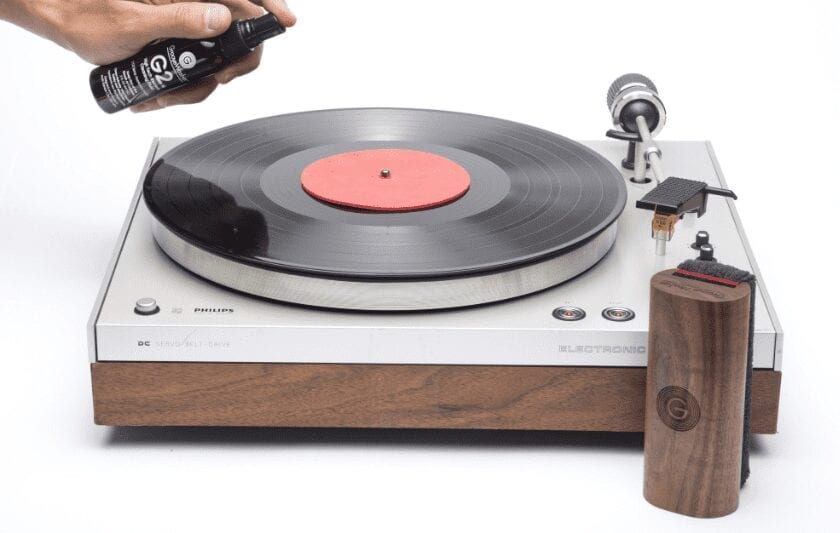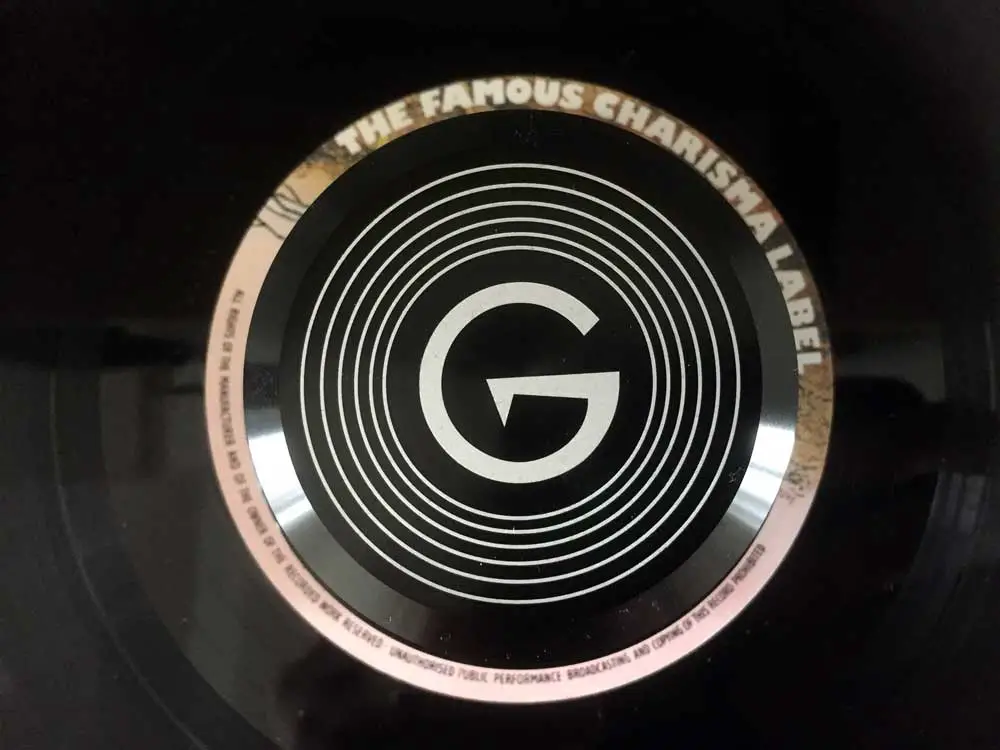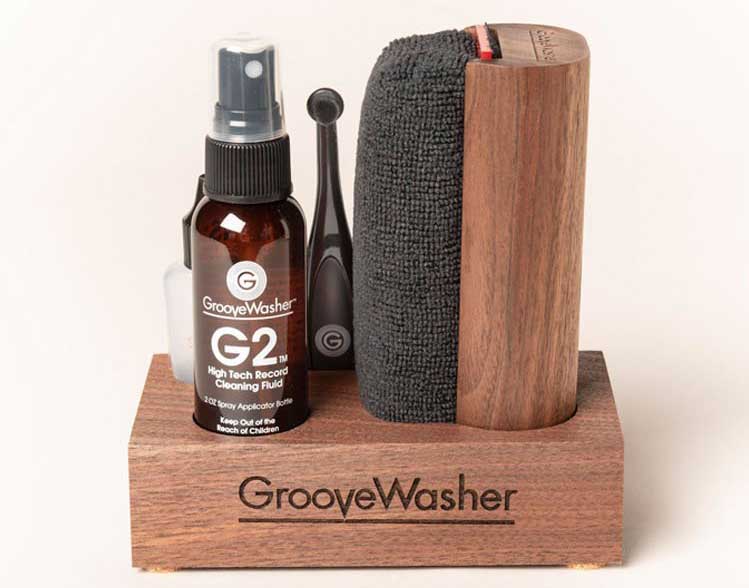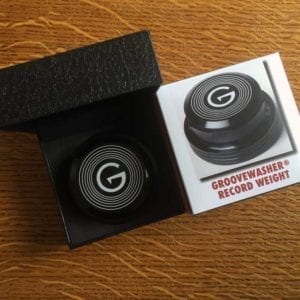Great sounding vinyl records are clean vinyl records, and few know more about this topic than GrooveWasher founder, Steve Chase. We talk to Steve about his journey in building a modern record cleaning system designed to enhance the listening experience for new and veteran vinyl enthusiasts. Steve also has some expert tips for our readers to help keep your precious records sounding great for many years to come.

The GrooveWasher system shares a linked history with the popular Discwasher cleaning kit from the 1970’s, can you tell us a little about that journey?
The inventor of the Discwasher record cleaning system was Dr Bruce Maier, PhD in Columbia, Missouri. He was an avid audiophile and a professor of microbiology at the University of Missouri. And an extremely bright, intellectual and creative guy. Dr Maier combined his love for Hi-Fi with his research in biology, chemistry and physics, with a sharp eye for design and style, to create the Discwasher record cleaning kit. He sourced local walnut for the handle (a wood species that was, and is, in wide use for high-end audio furniture, turntables and speakers). The result was an effective and classy looking record cleaning tool.
Dr Maier became a friend of mine in 1969 and he introduced me to high-end audio. Three years later, in 1972, he started the Discwasher company. My wife hired on as employee number 3 as part-time bookkeeper and helped with production. Later she became the Controller and continued with the company until Dr Maier sold it in 1982. During that decade, my family was immersed in the Discwasher company culture and business. Dr Maier was a business mentor for me. His aptitude for building a successful company was as great as his academic career.
Remember that the 70s predated the invention of cassette tapes and compact discs. Well engineered and manufactured vinyl records were the high-tech of their day. Even though some audiophiles used reel-to-reel tape recorders/players, vinyl was the most convenient medium to enjoy high-fidelity recorded music.
Audiophiles knew then, as they do now, that a dirty microgroove and/or stylus cannot reproduce the recorded music faithfully. There were many record cleaning products on the market then (as there are now) but none as effective and aesthetically pleasing as the Discwasher. From 1972 to 1982, Discwasher was the preferred manual record cleaning kit in the US and many other countries. During this decade, Dr Maier and his team created and introduced many additional audio accessories. Lots of them were big sellers but nothing like the original Discwasher record cleaning kit.
In 1974 Dr Maier obtained a patent for Discwasher, specifically his record cleaning fluid formulations and the mechanical action of the unidirectional fiber cleaning pad fabrics. He never revealed his record cleaning fluid formula to me, or anyone as far as I know. However, his patent described three variations of his early fluid formulas. (The chemical families described in his patent guided us in creating GrooveWasher record cleaning fluid.)
Compact tape cassettes improved in sound fidelity during the 70s and threatened the popularity of vinyl. Cassette tapes were much more convenient than vinyl and could be played in cars and portable players. Compact discs (CDs) arrived in 1985, which were even more convenient with higher sound fidelity than tape. By the late 80s, vinyl records were out of favor. Independent record stores adapted and added tapes and CDs and VHS and DVDs to survive. (Many did not.)
Fast forward to 2008. A small group of indie record store owners created Record Store Day (RSD) to promote the creation of new records. (Including limited editions to grab the imagination of young people to help grow demand for records again). Metallica and other popular musicians backed the idea. Now Record Store Day is a twice a year international phenomenon. RSD reinvigorated the love for vinyl records with older folks and introduced the superior sound quality to a new generation. Compared to digital music, records are inconvenient but so rewarding to the ear and eye.
Around 2010 my younger son (a musician and recording engineer) told me that some of the bands he was recording were releasing their music on vinyl. This was a revelation! I hadn’t listened to records very often for years. I realized I needed a “new” Discwasher and bought some on eBay. Of course, Dr Maier’s fluid in these kits was long gone so I researched how to make my own. Based on his patent descriptions, I found modern surfactants and wetting agents that were not available in the 70s. In 2015 I retired from 35 years in banking and decided to create a remaster of the vintage Discwasher. As my son said, “If you are going to listen to music on a physical medium, you must take care of it.” My family jumped in to help and GrooveWasher was born.

What makes GrooveWasher unique?
Many of our customers are discerning audiophiles. They have their choice of record cleaning solutions and tell us that G2 Fluid is their favorite. G2 Fluid is a balance between cleaning strength and a one-step process. Like the Discwasher fluids, no rinsing is needed. After wiping with high absorbency microfiber, and allowing a minute to air dry, the record is ready to play. No residue left in the groove. Just simple cleaning to let the honest sound of the record come through. It’s designed for cleaning records one at a time, just before play. Fast and convenient. Our handle design is also unique. Furniture quality solid milled walnut, like the vintage Discwasher, hand sanded and hand rubbed with water-proof clear oil polyurethane. Our carefully designed shape fits the hand comfortably. A bit smaller profile than the Discwasher with the same length. This handle will work and look great for decades. Our replaceable and washable cleaning pad, using velcro to hold the pad to the handle, is another innovation.

So GrooveWasher is perfect for everyday cleaning, what about record cleaning machines?
We have a lot of customers who use a record cleaning machine or bath to clean records in batches. They use our G2 Fluid for the cleaning step (often using our mist sprayer to apply the G2 Fluid), then vacuum and then the machine floods the record with the distilled water, followed by a final vacuum. After a record is well cleaned, they use their GrooveWasher for fine grooming and light dust removal just before play, dry or damp with a light mist of G2 on the cleaning pad, which temporarily removes static charge from the record surface.
There are some mixed views online about the use of isopropyl alcohol to clean records, where do you stand on this topic?
Dr Maier cautioned against fluids with high concentrations of iso alcohol. He stated that iso alcohol can remove plasticizers from the vinyl and make the groove brittle. Our G2 Fluid does not contain any iso alcohol. Some experts take pride in using high iso alcohol to clean their records. But it is not an effective hard surface cleaner. It evaporates too quickly to remove the contaminants. Try cleaning any hard surface with alcohol and you will see how poor a cleaner it is. The grime dries back onto the surface before you can wipe it away. I’ve met people who are proud to use iso alcohol and claim it does not harm the record. I’ve also met people who like to walk on the edge of cliffs…
The internet is awash with many home-made or improvised record cleaning methods. Are there any that you would advise against?
Common sense tells us that outrageous homemade methods might get a lot of Youtube views, but they aren’t effective in caring for the vinyl records we love. Wood glue – and 12 hours aside – it seems unnecessary when you can clean both sides of a record in a few minutes with GrooveWasher. RainX? Lysol? Windex? Ammonia? Dish detergent? Toothpaste? Everyone uses specialized cleaners in their lives. We can use toilet bowl cleaner to wash our hair. (And that would be an entertaining video!) But why would we? The G2 Fluid formula was guided by Dr Maier’s highly successful D2, D3 and D4 record cleaning fluids. It works great on vinyl records (and other delicate hard surfaces) because that is exactly what it is designed to do.
Vinyl records are still enjoying exponential growth with recent figures showing LP’s up 19.2% in 2018. What’s driving the resurgence from your perspective?
In my opinion, the resurgence is driven by buyers of records in two groups: Older folks like me who love the remastered, 180 gram pressings of rock and pop classics. And young people who listen to most of their music in digital formats, but also want the visual, tactile and auditory experience of their current pop and rock music on new vinyl.

This observation of the two groups is backed up by the vinyl sales charts. OfficialCharts.com lists the top 40 biggest selling vinyl albums of 2018 to date. Number one is Tranquility Base Hotel by Arctic Monkeys – a cutting edge current band. Number two is Rumours by Fleetwood Mac and number three is Pink Floyd’s The Dark Side of the Moon. Certainly, Arctic Monkeys appeal mostly to young people while Rumours and Dark Side of the Moon are most likely popular with older music fans. Both groups are passionate about their favorite music and performers. They are certainly backing up their passion with their wallets!
What advice can you add for our readers who might just be getting started with vinyl record care?
Read the Sound Matters articles, for one accurate information source. Watch the Youtube videos (GrooveWasher has some good ones) but use your own common sense and ignore the silliness. You can get more detailed info on Discogs and the various audio forums (look out for trolls and some occasional misinformation).
Our audiophile friends have some basic advice:
- When you buy a new or vintage record the inner sleeve is likely plain paper or low-quality plastic. Replace with a high-quality inner sleeve. We prefer the white paper with poly lining. The MOFI sleeves are ok.
- Thoroughly clean both sides of the record with G2 Fluid and our cleaning pad or microfiber towel, off the turntable on a soft cotton or microfiber towel (we have a new round towel coming for this purpose). Allow the record to dry for a minute or two before playing the first time. (Some experts advise allowing a newly cleaned record to dry for an hour or more before playing.) Before putting the record in the new inner sleeve, allow to air dry for at least an hour. Always put the inner sleeve back in the jacket with the open side up inside the jacket. Never store a record with the inner sleeve opening aligned with the opening of the jacket. This may save a few seconds to pull the record out to play. But the risk of room dust and other contamination getting on the record is high.
- If the record jacket is dirty or mildewy, lightly wipe it with a G2 Fluid dampened microfiber towel. Be careful not to wet the jacket too much or you can harm the printing. Allow to dry then insert the record and jacket in a high-quality outer (3 or 4 mil) plastic sleeve. This will protect the jacket for years.
- Store your records vertically, at least 6 inches above the floor (in case of a floor flooding event, etc) in a cool, minimal sunlight space.
- Before every play of a previously cleaned record, lightly groom the record with your GrooveWasher brush or microfiber towel. Dampen the fabric and gently remove any dust particles and static. You can do this with the record on the turntable, (in most cases) without harm.
- Before every play, use a good quality stylus brush (and, if necessary, a drop of stylus cleaning fluid on the brush)—we recommend the GrooveWasher Stylus Cleaning Kit of course—to remove any accumulated dust or grime on the stylus.
Your product portfolio is growing fast; what can we expect to see next from GrooveWasher?
 We want to be relevant for our customers and the record and audio stores that carry our products. So we want to offer the highest quality accessories and tools, with innovations where we can make them. Any ideas you or your readers have are welcome!
We want to be relevant for our customers and the record and audio stores that carry our products. So we want to offer the highest quality accessories and tools, with innovations where we can make them. Any ideas you or your readers have are welcome!
New or Upcoming:
- Record Stabilizer Weight (Black).
- Record Stabilizer Weight and matching 45 adapter (our own custom red spiral design)
- Acrylic Storage Box. Dustproof box, custom designed to hold our walnut block, GrooveWasher Walnut Kit and SC1 Stylus Kit. The storage box is available separately or with all the components. This will be our new “Magnum Kit”.
- Cowhide leather, antistatic platter mats in tons of colors. Made by our friends at Hide in the Sound.
- The Commando Record Cleaning Kit (entry level, low priced kit)
- Two “Splash Record Towels”—Round microfiber towels printed with our custom artwork to resemble a bright splash LP. A 16-inch diameter towel to place the record on during off turntable cleaning. And a 5 ft diameter music festival or beach towel. Same art design on both.
- For fun and for holiday gift giving, we will offer a package of 6 recycled record label drink coasters. Made by our friends at Vinylux.
- G3-HD Record Cleaning Fluid. For customers looking for a stronger version of our G2 Fluid. Formulated for especially dirty or moldy records from estate sales and thrift stores.
Learn more at GrooveWasher.com – Sound Matters readers can enjoy 10% off when shopping directly at groovewasher.com by using the discount code SOUNDMATTERS10



I bought a Discwasher record cleaning kit in 1977, just before I started college, and it included an anti-static gun, using a piezoelectric crystal to shoot ions at the record. The idea was that the ions would neutralize any static charges on the record’s surface, and prevent new dust from sticking to the record’s surface after cleaning. Have you guys heard of this? Any comments would be welcome.
Best thing about early discwasher over all others was brush! The fine bi-directional fibers actually went into grooves, cleaning without damaging. Other brushes damaged grooves if they entered them; most were just fabric that actually packed dirt & grime into grooves. Hoe does groove master fabric compare?
I still have my discwasher kit from the 70’s. It even has the Zerostat anti static “gun”.
Just recently bought a new turntable for my vinyl and been enjoying the sounds I haven’t heard since the late 80’s
Hi
I’m a freelance writer from Pittsburgh PA and am interested in writing an article on the Discwasher. I read your article and was wondering if Dr Bruce Maier is still alive?
I actually came across the Dischwasher by someone who worked at the Quincy Paper Box Company when Dr. Maier knocked on their door to manufacture the box that held the Discwasher. And that peaked my interest. I wrote a story on the Valentine boxes their company made.
I’d like to speak with him and you for my article if possible.
Thank you,
Mary Lynn Davidek Alpino
Thanks for the history of the discwasher.
[…] err on the side of caution when considering alcohol as a record cleaning ingredient. In our previous interview with GrooveWasher founder, Steve Chase, he explained why the creator of the original 1970’s Discwasher, Dr Bruce Maier […]